CSOs for Disaster Resilience
Empowering civil society organisation and local communities to build resilience to hurricanes and climate extremes in the Eastern Caribbean
The projects seeks to build resilience in local communities against hurricanes and climate extremes in the Eastern Caribbean by incorporating the use of community & ecosystem- based disaster risk reduction (CBDRR/Eco-DRR). The selected community will undergo a Vulnerability Capacity Assessment ( VCA), which involves speaking with residents to identify vulnerable/ at risk areas that are prone to the effects of hurricanes and other climate extremes.
This project is funded by the Inter-American foundation (IAF), presented by the Caribbean Natural Resource Institute (CANARI) and implemented by Grenada Education and Development Programme (GRENED).
A total to 2 communities, Balthazar & Telescope were selected for this project to address the environmental issues faced for years based on the vulnerability capacity assessment done. Each solution developed must be nature-based / green, such as planting trees according to the funder for the project. This is a necessary approach to restore lost or damaged ecosystems and for involved project parties and community residents rely on / move forward with using more nature-based /green solution when address environmental issues or impacts in the future.
Balthazar Community

The Balthazar Community is located on the eastern side of the island of Grenada, 3 miles west of the town of Grenville. The village of Balthazar, locally known as Camblair, was named from the Balthazar Estate, first owned by Edward Julias de Poullain in 1817.This village was and is noted as being best suited for agricultural production, because of an assured water-supply, being located on a riverbank and also because of its rich soil. The community thus has an agricultural background with many residents involved in farming, doing their own small production and also working with other farmers outside the village.
A number of persons are also engaged in construction work and travel out of the community on a daily basis to engage in that trade, returning in the late evening. The Balthazar community is considered to be one of the most affected areas in Grenada from the impacts of natural hazards, particularly flooding and soil erosion which happen mainly on riverbanks.
Such hazards are influenced by extreme rainfall events in combination with the actual overflowing of the river, known as the Great River. Up to this present day, older villagers can tell of horrific experiences thy have had, such as the sudden loss of homes during floods, resulting in forced relocation, and the loss of livelihood due to the destruction of economic resources such as agricultural crops and livestock on which people depend. Many villagers have reported that flooding is becoming more severe.
Farmers who have little or no measures to protect their crops from the incoming floods, suffer particularly. In addition, the flooding has been contributing to erosion of the riverbanks, impacting especially those residents living close to the water’s edge. A key community asset is immediately threatened — a playing field utilized by villagers of all ages but especially young males, floods very heavily when it rains. Measures previously put in place, such as an early warning system initially set up by the National Disaster Management Agency (NaDMA) in 2010 is no longer present as it was destroyed by the river during a heavy rainfall event.
Goal: Reduced impact of flooding in Balthazar Village through riverbank restoration and maintenance, and increased community knowledge on the use and benefits of nature based-solutions such as the planting of trees and other vegetation to mitigate future
impacts.
Balthazar Project activities
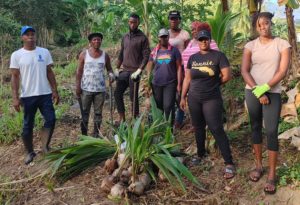
A few of the Balthazar team, ready to save their eroding river bank by planting trees, whose root are well adapted in holding soil particles together, slowing the rate of erosion by the overflowing river.
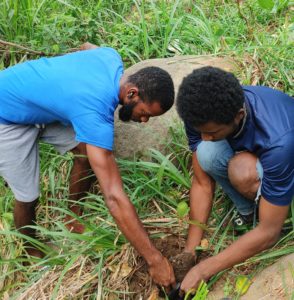
Almonds were also planted because of their roots and economic potential for the community.
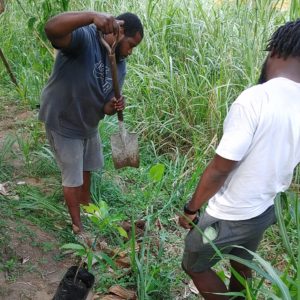
Mango trees were also among the list of trees planted on the river bank because of its economic value.
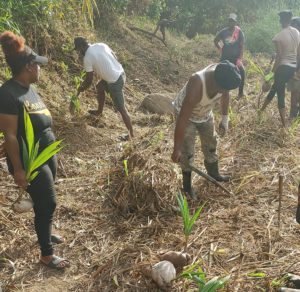
On the ground work being done by the residents of Balthazar. Their first day of planting includes coconuts trees recommended by the agro-forestry expert, because of their ability to hold soil together with their fibrous roots
CSOs for Disaster Resilience – Spotlight on practical action projects: Balthazar, Grenada.
Telescope Community
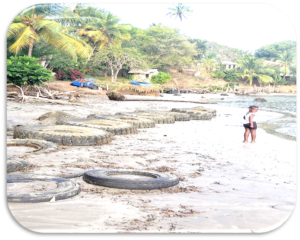
Located approximately half a mile from Grenville within the parish of St. Andrews; Telescope is one of the largest communities in eastern Grenada. The norther barrier reef within the larger Grenville Bay area (of which Telescope is situated as part of the larger Grenville area) has deteriorated significantly over the years due to erosion and other natural as well as human influences. Telescope is considered high risk because it is a low-lying coastal community with significant income, housing and other asset-poverty, which means that scores of residents do not have sufficient material and other resources to respond to threats or events. Historically the community was colonized by the Spanish, French and British, leading to the retreat of the original indigenous community.
The community was converted into an estate. Estate conversion brought about practices such as mangrove cutting for burning of coals, and deforestation for establishment of housing settlements. These practices have continued to present day – with deforestation and unsustainable harvesting of mangroves in order to produce charcoal continuing by community residents; thereby decreasing the mangrove vegetation which should act as the first natural line of defense on the coastline. The community has historically depended heavily on the natural resources, leading to problems with effective conservation and management of natural resources. Over the years the sale of land opened up the area for settlement and several other developmental activities took place including building of a secondary school, a coffee plant (which was used as a means of employment for the villagers. The issue of sand mining became a critical matter as this led to beach/coastal erosion and degradation of marine resources.
Goal: To protect the coast from erosion caused by continuous wave action and other environmental hazards, by incorporating the use of community education and awareness with green solutions such as trees, and possible mangrove restoration.
Telescope Project activities
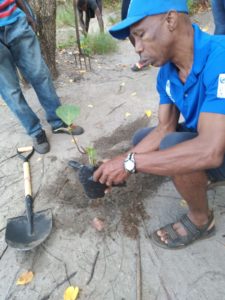
The Agro-forestry expert, Mr. Aiden Forteau demonstrating to the community on how to properly transplant the almond plants from their plastic containment to the ground.

The Telescope community enagsging in planting activity to help restore their eroding coastline, Almond seedlings are being prepared to be transplanted on the coast
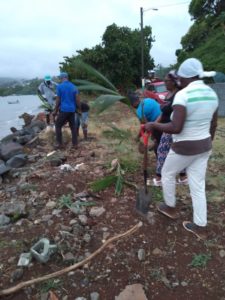
More field work done by the community members of Telescope in unity, to save their land and home from destruction.
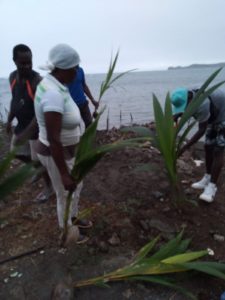
Coconuts were also planted on the Telescope coastline to prevent erosion, and to replace what was lost years ago by the violent wave action.
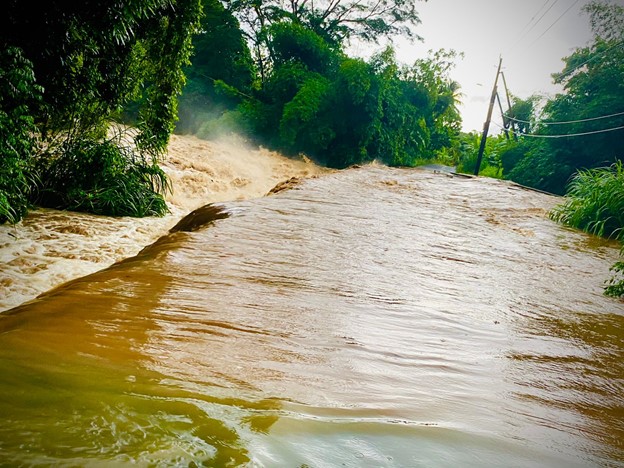
No responses yet